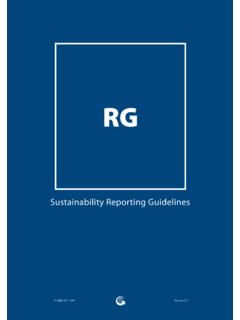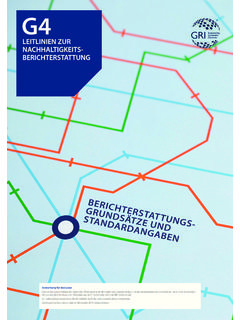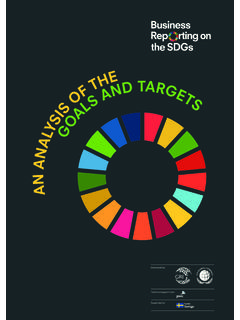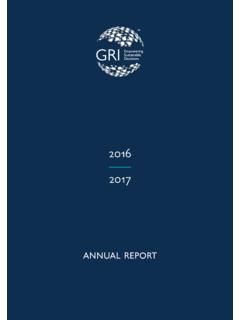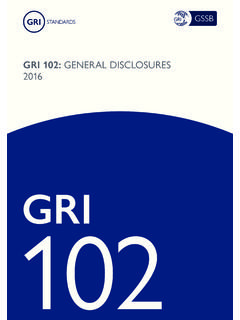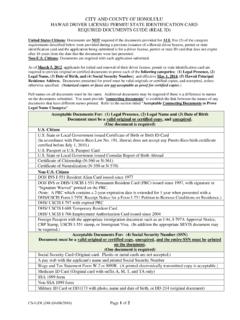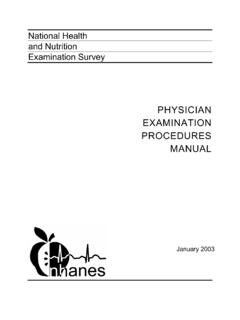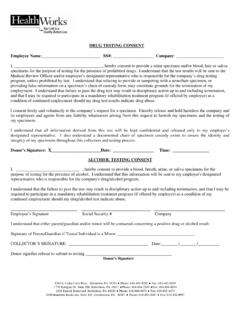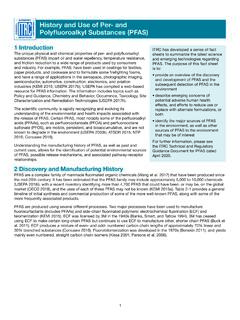Transcription of GRI 202 Market Presence 2016 - Global Reporting Initiative
1 GRI 202: Market Presence . 2016. GRI. 202. Contents Introduction 3. GRI 202: Market Presence 5. 1. Management approach disclosures 5. 2. Topic-speci c disclosures 6. Disclosure 202-1 R. atios of standard entry level wage by gender compared to local minimum wage 6. Disclosure 202-2 P. roportion of senior management hired from the local community 8. Glossary 9. References 11. About this Standard Responsibility This Standard is issued by the Global Sustainability Standards Board (GSSB). Any feedback on the GRI Standards can be submitted to for the consideration of the GSSB. Scope GRI 202: Market Presence sets out Reporting requirements on the topic of Market Presence . This Standard can be used by an organization of any size, type, sector or geographic location that wants to report on its impacts related to this topic.
2 Normative This Standard is to be used together with the most recent versions of the following references documents. GRI 101: Foundation GRI 103: Management Approach GRI Standards Glossary In the text of this Standard, terms de ned in the Glossary are underlined. Effective date This Standard is effective for reports or other materials published on or after 1 July 2018. Earlier adoption is encouraged. Note: This document includes hyperlinks to other Standards. In most browsers, using ctrl' + click will open external links in a new browser window. After clicking on a link, use alt' + left arrow to return to the previous view. 2 GRI 202: Market Presence 2016. Introduction A. Overview An organization then selects from the set of topic- specific GRI Standards for Reporting on its material This Standard is part of the set of GRI Sustainability topics.
3 These Standards are organized into three series: Reporting Standards (GRI Standards). These Standards 200 (Economic topics), 300 (Environmental topics) and are designed to be used by organizations to report 400 (Social topics). about their impacts on the economy, the environment, and society. Each topic Standard includes disclosures specific to that topic, and is designed to be used together with The GRI Standards are structured as a set of GRI 103: Management Approach, which is used to interrelated, modular standards. The full set can be report the management approach for the topic. downloaded at GRI 202: Market Presence is a topic-specific GRI. There are three universal Standards that apply to every Standard in the 200 series (Economic topics).
4 Organization preparing a sustainability report: GRI 101: Foundation GRI 102: General Disclosures B. Using the GRI Standards and making claims GRI 103: Management Approach There are two basic approaches for using the GRI. Standards. For each way of using the Standards there GRI 101: Foundation is the starting point for using is a corresponding claim, or statement of use, which the GRI Standards. It has essential information an organization is required to include in any published on how to use and reference the Standards. materials. Figure 1. 1. T. he GRI Standards can be used as a set to prepare Overview of the set of GRI Standards a sustainability report that is in accordance with the Standards. There are two options for preparing Foundation Starting point a report in accordance (Core or Comprehensive), for using the depending on the extent of disclosures included in GRI Standards the report.
5 GRI. 101 An organization preparing a report in accordance Universal with the GRI Standards uses this Standard, Standards GRI 202: Market Presence , if this is one of its General Management material topics. Disclosures Approach GRI GRI 2. S elected GRI Standards, or parts of their content, 102 103 can also be used to report specific information, without preparing a report in accordance with To report contextual To report the the Standards. Any published materials that use information about management approach an organization for each material topic the GRI Standards in this way are to include a GRI-referenced' claim. See Section 3 of GRI 101: Foundation for more Economic Environmental Social information on how to use the GRI Standards, Topic- specific and the specific claims that organizations are Standards GRI GRI GRI required to include in any published materials.
6 200 300 400. Select from these to report specific disclosures for each material topic GRI 202: Market Presence 2016 3. C. Requirements, recommendations and guidance The GRI Standards include: Requirements. These are mandatory instructions. In the text, requirements are presented in bold font and indicated with the word shall'. Requirements are to be read in the context of recommendations and guidance; however, an organization is not required to comply with recommendations or guidance in order to claim that a report has been prepared in accordance with the Standards. Recommendations. These are cases where a particular course of action is encouraged, but not required. In the text, the word should' indicates a recommendation.
7 Guidance. These sections include background information, explanations and examples to help organizations better understand the requirements. An organization is required to comply with all applicable requirements in order to claim that its report has been prepared in accordance with the GRI Standards. See GRI 101: Foundation for more information. D. Background context In the context of the GRI Standards, the economic dimension of sustainability concerns an organization's impacts on the economic conditions of its stakeholders, and on economic systems at local, national, and Global levels. It does not focus on the financial condition of an organization. The Standards in the Economic series (200) address the flow of capital among different stakeholders, and the main economic impacts of an organization throughout society.
8 GRI 202 addresses the topic of an organization's Market Presence , covering its contribution to economic development in the local areas or communities where it operates. For example, this can include the organization's approaches to remuneration or local hiring. The disclosures in this Standard can provide information about an organization's impacts related to Market Presence , and how it manages them. 4 GRI 202: Market Presence 2016. GRI 202: Market Presence This Standard includes disclosures on the management approach and topic-specific disclosures. These are set out in the Standard as follows: Management approach disclosures (this section references GRI 103). Disclosure 202-1 R atios of standard entry level wage by gender compared to local minimum wage Disclosure 202-2 P.
9 Roportion of senior management hired from the local community 1. Management approach disclosures Management approach disclosures are a narrative explanation of how an organization manages a material topic, the associated impacts, and stakeholders' reasonable expectations and interests. Any organization that claims its report has been prepared in accordance with the GRI Standards is required to report on its management approach for every material topic, as well as Reporting topic-specific disclosures for those topics. Therefore, this topic-specific Standard is designed to be used together with GRI 103: Management Approach in order to provide full disclosure of the organization's impacts. GRI 103 specifies how to report on the management approach and what information to provide.
10 Reporting requirements The Reporting organization shall report its management approach for Market Presence using GRI 103: Management Approach. GRI 202: Market Presence 2016 5. 2. Topic-specific disclosures An organization is expected to compile information for economic disclosures using figures from its audited financial statements or from its internally-audited management accounts, whenever possible. Data can be compiled using, for example: the relevant International Financial Reporting Standards (IFRS), published by the International Accounting Standards Board (IASB), and the Interpretations developed by the IFRS Interpretations Committee (specific IFRS are referenced for some of the disclosures);. the International Public Sector Accounting Standards (IPSAS) issued by the International Federation of Accountants (IFAC).
